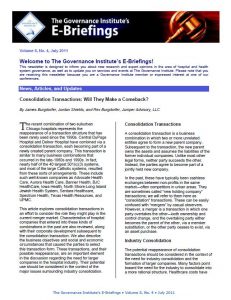Consolidation Transactions: Will They Make a Comeback?
 The recent combination of two suburban Chicago hospitals represents the reappearance of a transaction structure that has been rarely used since the 1990s. Central DuPage Hospital and Delnor Hospital have combined via a consolidation transaction, each becoming part of a newly created parent company. This transaction is similar to many business combinations that occurred in the late-1980s and 1990s. In fact, nearly half of the 40 largest 501(c)(3) systems, and most of the large Catholic systems, resulted from these sorts of arrangements. These include such well-known companies as Advocate Health Care, Aurora Health Care, Banner Health, BJC HealthCare, Iowa Health, North Shore-Long Island Jewish Health System, Sentara Healthcare, Spectrum Health, Texas Health Resources, and UPMC.
The recent combination of two suburban Chicago hospitals represents the reappearance of a transaction structure that has been rarely used since the 1990s. Central DuPage Hospital and Delnor Hospital have combined via a consolidation transaction, each becoming part of a newly created parent company. This transaction is similar to many business combinations that occurred in the late-1980s and 1990s. In fact, nearly half of the 40 largest 501(c)(3) systems, and most of the large Catholic systems, resulted from these sorts of arrangements. These include such well-known companies as Advocate Health Care, Aurora Health Care, Banner Health, BJC HealthCare, Iowa Health, North Shore-Long Island Jewish Health System, Sentara Healthcare, Spectrum Health, Texas Health Resources, and UPMC.
This article explores consolidation transactions in an effort to consider the role they might play in the current merger market. Characteristics of hospital companies that entered into these kinds of combinations in the past are also reviewed, along with their corporate development subsequent to the consolidation transaction. We also describe the business objectives and social and economic circumstances that caused the parties to select this transaction form. These transactions, and their possible reappearance, are an important element in the discussion regarding the need for larger companies in the hospital industry. Their potential use should be considered in the context of the major issues surrounding industry consolidation.
Consolidation Transactions
A consolidation transaction is a business combination in which two or more unrelated entities agree to form a new parent company. Subsequent to the transaction, the new parent owns the assets and assumes the liabilities of the former individual companies. Unlike most other legal forms, neither party succeeds the other. Instead, the parties agree to become part of a jointly held new company. In the past, these have typically been cashless exchanges between non-profits in the same market—often competitors in urban areas. They are sometimes called “new holding company” transactions; we will refer to them here as “consolidation” transactions. These can be easily confused with “mergers” by casual observers. However, a merger is a transaction in which one party overtakes the other—both ownership and control change, and the overtaking party either becomes the parent of the other, via a member substitution, or the other party ceases to exist, via an asset purchase.